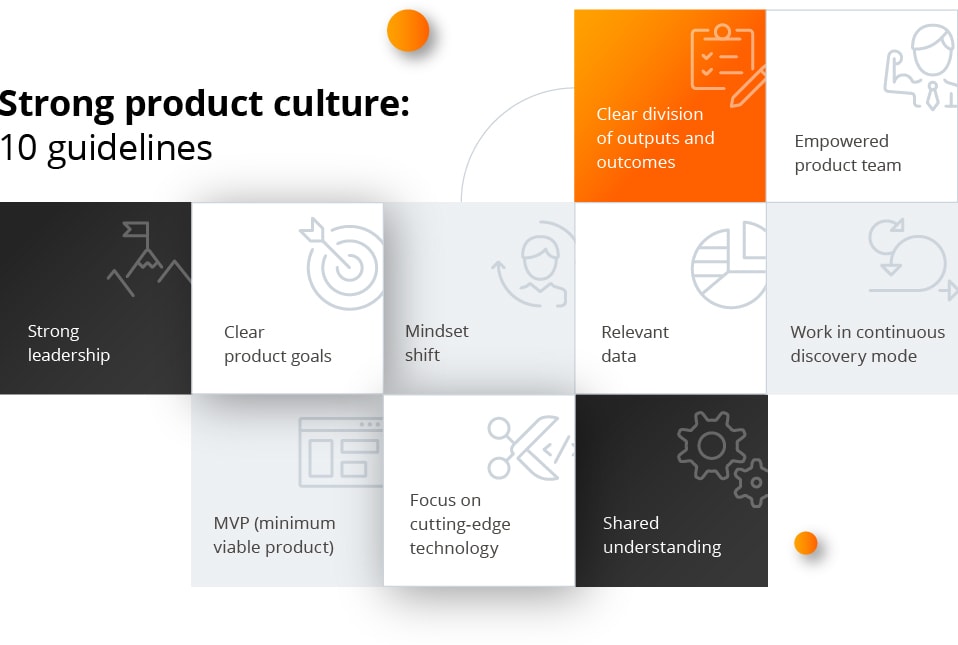
How to Create a Product Development Roadmap?
A product development roadmap is a strategic document which includes a high-level plan of actions, objectives, milestones, and deadlines for a product — including its ultimate vision and functionality.
It’s designed to serve as a navigation point and provide the main context for everyone involved in product development, from the startup founders and project executives down to the development team.
Today, we will guide you through some fundamental issues related to the product roadmap so that you know what the fuss is all about and how your project can benefit from creating a document like this.
What is a product development roadmap, and why do you need one?
A product development roadmap is your guiding star for how to build your product. It helps everyone understand the big goals, aligns the team’s work with the product’s vision, and keeps track of what’s being created and when.
Vision and Strategy Outline: The roadmap presents the high-level objectives and strategies to achieve them.
Alignment Tool: The purpose of this document is to communicate the rationale and goals of the product. Team members and stakeholders can better see the big picture when this happens.
Decision-making Framework: It guides the decision-making process. It is useful for prioritising tasks and ensuring that development aligns with the product’s strategic goals.
Timeline and Feature Planning: The document includes a timeline to track the expected release of new features and major updates.
Idea to Execution: The product roadmap is more than simply a collection of ideas; it’s a set of instructions for making the product a reality. From idea to finished product, it lays out the whole process.
Benefits of having a product roadmap in product management
Focus: First and foremost, a product roadmap will help you stay on the path to achieving your goals. Whenever someone is unsure what to do or how to handle an issue, taking a peek at the objectives, priorities, or even written outlines of their responsibilities can be very helpful.
Management: Managing the product backlog is much more difficult when you don’t have your vision, strategy, and goals put together in one document. Also, since the roadmap shouldn’t be set in stone, you always have the opportunity to step back, take a broader perspective, and modify the document as needed, setting the project on the right track.
Communication: A product development roadmap helps clarify the reasons behind your actions and “the why” behind your goals. Depending on the type of roadmap — you can use it in both internal and external communications (with employees and key stakeholders, as well as customers).
Learn more:
Product Development Roadmap vs. Product Roadmap: what’s the difference?
The difference between a product development roadmap and a product roadmap comes down to what they focus on and the time they cover.
A product roadmap, often managed by product teams, is a big-picture plan that shows how a product is expected to grow over time, aligning with the product vision. It shares the overall strategy for the product with everyone involved.
This roadmap, sometimes referred to as an agile product roadmap, looks at long-term goals and major steps in the product’s journey, usually over many months or years. It doesn’t change much because it’s about the general direction of the product.
In contrast, a product development roadmap is a more detailed plan that focuses on building the product and getting it ready for customers. It breaks down the work needed into specific tasks, deadlines, and important points in the development process.
This roadmap is about short-term work and is updated often to keep up with the progress and changes in the development phase.
Key elements of a successful Product Development Roadmaps
Creating a successful product development roadmap involves integrating several key elements.
Let’s break them down:
Product Vision: Clearly defines what you want the product to achieve in the long run. It’s a straightforward guide for your product’s future.
Product Strategy: Outlines the plan to reach the product vision. It includes setting priorities and directions to follow over time.
Requirements: Details what the product needs, like specific features and technical aspects. This is based on what stakeholders expect from the product.
Product Plan: Describes how you’ll execute the strategy. It should be flexible to adapt to changes over time.
Markers: Identifies important milestones and deliverables. These serve as checkpoints to gauge progress.
Monitoring: Defines how you’ll measure the product’s DSI (Delivery Success Indicators), ensuring everyone is working towards the same strategic goals.

4 steps to design an effective Product Development Roadmap
If you’re not sure how to create an effective roadmap for your product development, follow these four essential steps to guide you through the process.
1. Setting clear goals and milestones in the product development roadmap
You need to know why you want to build this product, how it is going to help its users, and what benefits this will bring to your business. Objectives can be general and more mission-like in order to engage and inspire your team. The results, on the other hand, have to be very specific and quantifiable.
Don’t go too deep into details! A product roadmap provides context for your project; it shouldn’t be a rigid step-by-step guide. You need to leave some room to make any necessary adjustments and modifications.
A key mistake in product roadmap development is ignoring the ‘why’. Knowing what you’re building and who it’s for is important, but the core reason behind the product is vital. This understanding shapes your vision and aligns all team members towards common goals, ensuring consistency in the final product.
Consider these questions to clarify your product’s purpose:
Why are you developing this product now?
What user needs will it address?
2. Prioritising features in your product strategy
Prioritising features in a product development roadmap begins with a deep understanding of your potential customers. Describe your potential customers carefully — build buyer personas in order to create a product that will answer their specific needs.
This is not a classified document — an product roadmap is a navigational beacon of sorts for each and every team member. It’s a way to ensure that all internal teams, from product managers to sales team, developers, UX Designers and marketers, are on the same page and know the priorities. Focus on product features is critical to this alignment, as it helps teams orientate on what matters most to the customer and the business.
In order to cultivate a product culture and common goal-setting, it is important to keep each other informed and involved through consistent reporting of progress and outcomes.
Build your team, define roles and responsibilities, and assign tasks so everyone knows exactly what to do and who answers to whom. Choose a reliable product manager.
Remember that establishing clear lines of communication and accountability is essential for efficient project management. This will help your employees avoid any confusion and misunderstandings.
3. Visualising your product development journey
Using tools to create a product roadmap document not only streamlines the planning process but also ensures that your plan is accessible to all stakeholders, regardless of their technical expertise. For example, tools such as Aha! or Roadmunk will allow you to create attractive visual roadmaps effectively.
Your first step is to determine the vision and strategy. Then, it’s time for development teams to focus on the details:
timeframes (put milestones in chronological order),
features (deliver value to end-users),
MVP (focus on core functionalities only),
metrics (determine if the results meet the assumptions)
Once you’ve created your product development roadmap and done it wisely, you will start experiencing benefits that will manifest themselves in your day-to-day activities.
4. Measuring progress and success
It is important to measure metrics to ensure that a product development roadmap progresses well and aligns with business goals and customer needs. This can be achieved by following these steps:
Defining clear objectives,
Selecting relevant KPIs,
Balancing quantitative and qualitative metrics,
Implementing data collection and tracking systems,
Gathering customer feedback,
Establishing regular reporting to monitor performance.
All of these elements are necessary, as any changes that influence the project, whether internal or external, require you to act quickly. So, the roadmap should be agile enough to adapt to the changes in the product development processes.
Best Practices for Product Roadmaps
Choose an adequate roadmap format, e.g.:
feature-based (tracks product features – their development and releases),
goal-oriented (focuses mainly on achieving goals and providing benefits),
now-next-later (outlines priorities without committing to specific timelines and enables flexibility in terms of making changes in ever-changing environments).

Research and deliver at the same time: Discovering and delivering products should be balanced endeavours. While it’s critical to satisfy internal teams, it’s just as critical to keep up with your consumers’ changing wants. In order to keep a focus on the user, allocate resources to ongoing digital product discovery, not only on product delivery.
Keep the document updated: Never let your roadmaps go out of date. It is important to keep your product roadmap templates current as priorities change and new decisions are made.
Don’t overpromise: It’s crucial to be realistic about what you can achieve on your roadmap and avoid overpromising to stakeholders. Doing so will help you keep the trust and prevent any potential disappointment.
Feedback first: Set up a system where stakeholders may give you their thoughts and opinions on the roadmap. Establish channels for receiving feedback, comments, and ideas from clients, coworkers, and other relevant stakeholders to encourage open dialogue and teamwork.

Why is continuous improvement vital in product roadmap development?
Regularly updating the roadmap helps organisations to optimise resources, prioritise important initiatives, and focus on end-users. This aligns with agile transformation, promotes adaptability, and leads to more effective product solutions.
If you are not sure, however, how to keep the product map current, or in fact, you face challenges in creating this sort of document, do not worry – a great product development roadmap is something that can be developed in our Discovery Workshop, so if you want to make sure that everything is done properly, just get in touch with us!
Future Processing can provide valuable expertise and guidance on the topic. Our team is experienced in helping organisations create effective roadmaps that align with their goals and customer needs.
Reach out to us for expert assistance in shaping your product’s journey!




